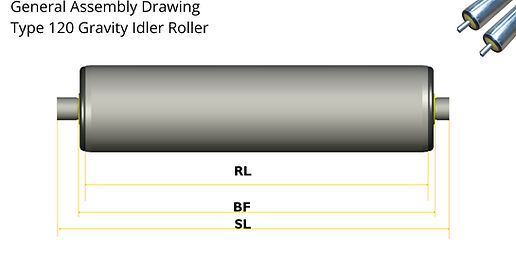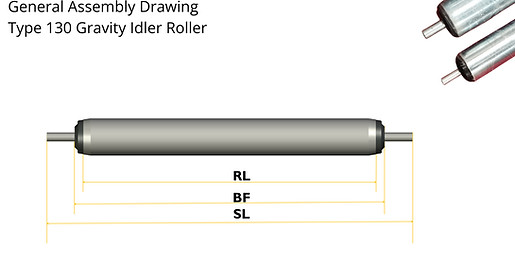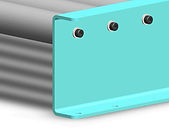16 Options to Choose for
Gravity / Idler Rollers
Maximize Your Efficiency with Premium Rollers: Gravity Rollers, Free Rollers, and Idler Rollers
When it comes to material handling and conveyor systems, the right rollers can make all the difference in efficiency and performance. At [Your Company Name], we provide high-quality gravity rollers, free rollers, and idler rollers designed to optimize your workflow and streamline operations.
Gravity Rollers: Ideal for applications that rely on the natural force of gravity, our gravity rollers are engineered for durability and smooth movement. These rollers are perfect for gravity-fed conveyor systems, ensuring products move seamlessly without the need for powered motors.
Free Rollers: Our free rollers are versatile and free-turning, offering effortless rotation. These rollers are commonly used in light-duty applications, providing a cost-effective solution for moving items that require low friction and smooth transfer.
Idler Rollers: Engineered to support your conveyor belt and keep it aligned, idler rollers play a crucial role in reducing wear and tear on your equipment. Our heavy-duty idler rollers are built to handle continuous use and ensure reliable operation in demanding environments.
Whether you're in need of gravity rollers, free rollers, or idler rollers .. Excel Conveyors has the solutions you can trust. Our rollers are designed for maximum durability, smooth operation, and cost-effectiveness, making them the perfect choice for any conveyor system.
Contact us today to learn more about how our gravity rollers, free rollers, and idler rollers can boost the performance of your conveyor system.
3 Types of Construction Options as below
Type120 Gravity Rollers
Features of Type 120 Gravity Rollers
_edited.jpg)
-
Materials - Carbon Steel / Stainless Steel
-
Bearing Housing - Polymide Molded
-
Sizes - Roller Dia. & Shaft combination as per standard table below
-
Length - made to order
-
Load Capacity - reference table below
-
Surface Treatments
-
Carbon steel - Zinc Plated, Chrome plated
-
SS - Mirror Polished
-
-
Coatings - PU Coated, PVC Sleeve
-
Working Temp - Room Temp.
Standard Sizes available in Type120 Gravity Rollers
Below Combination of Roller Dia. X Thickness X Shaft Dia. is fixed
Lengths are customized as per requirement.
Type130 Gravity Rollers


Features of Type130 Gravity Rollers
Materials - Carbon Steel / Stainless Steel
-
Bearing Housing - Polymide Molded
-
Sizes - Roller Dia. & Shaft combination as per standard table below
-
Length - made to order
-
Load Capacity - reference table below
-
Surface Treatments
-
Carbon steel - Zinc Plated, Chrome plated
-
SS - Mirror Polished
-
-
Coatings - PU Coated, PVC Sleeve
-
Working Temp - Room Temp.
Standard Sizes available in Type130 Gravity Rollers
Type110 PVC Gravity Rollers


Features of Type110 Gravity Rollers
-
Materials - PVC Grey
-
Bearing Housing - Polymide Molded
-
Sizes - Roller Dia. & Shaft combination as per standard table below
-
Length - MAX 800mm
-
Working Temp - Room Temp.
Standard Sizes available in Type110 Gravity Rollers
Load Capacity of Conveyor Rollers
Understanding Load Capacity in Conveyor Rollers
Our conveyor rollers are designed to efficiently handle various loads, and it's crucial for designers and users of gravity conveyors to grasp the nuances of load capacity. The information provided below, based on roller lengths in mm and diameters, offers insights into load-bearing capabilities. However, it's essential to note that these figures serve as references and indicators, subject to variations based on component materials and working conditions.
Distribution, Not Concentric:
It's imperative to recognize that the load-carrying capacity of our rollers is distributive, not concentric. In other words, the capacity is not solely determined by a point load. Instead, it considers the distribution of the load along the length of the roller.
Inverse Relationship with Length:
The load-carrying capacity demonstrates an inverse relationship with the length of the rollers. As roller length increases, the capacity decreases. This understanding is pivotal for optimal conveyor design, ensuring that the system is tailored to handle loads efficiently.
Consideration for High-Width Products:
For products with greater width, it's important to note that a proportional increase in roller diameter may be necessary to maintain the desired load capacity. This ensures that the conveyor system can effectively handle the demands of high-width items.
Please be aware that the load capacities provided are for reference and indicative purposes only. The actual capacity may vary based on factors such as component materials and specific working conditions
At Excel Conveyors, we prioritize transparency and knowledge-sharing to empower our users in designing and operating gravity conveyors effectively. If you have further inquiries or need detailed specifications, we encourage you to reach out, and our team will be delighted to assist you.
Please note that the Load capacity is mentioned in Kgs in below Table
Roller Mounting Options Available
There are various options available to mount the rollers in the frame
Female Threaded Shaft
The Shaft is having female threads ( female tap) and fitted between the frames with Bolts.
This is most widely used method


Spring Loaded Rollers
The Shaft is assembled with spring, so the shaft having spring back action. This makes the roller installation superfast eliminating fasteners application and saving manpower.
Milled End or Across Flat
The milled end or across flat is given to the shaft and is placed into a slotted c frame.

Other Options for roller mounting
There are lot many options such as cross drill, Spring Back + Milled end etc. The selection of the same depends on the application requirement
as well as user requirement.
Gravity Or Idler Rollers Coating Options
Conveyor Rollers have lot of coating options available as below.
Zinc Plating
-
Also known as Zinc Blue white passivation
-
This is most widely done coating process for Rollers
-
It gives 3-5 micron shiny white appearance
-
Cost effective process
-
Fast compared to other process.
-
This process is used in packaging areas where carton boxes, crates etc are to be conveyed

Chrome Plating
-
This process is done vary rarely
-
When there are chances of scratches on the roller, then this process is done to protect the roller.
-
It gives 5 micron shiny white appearance
-
The coating thickness can be increased
-
Very Costly process
-
Very Time Consuming, compared to other process.
-
Auto-ancillary companies prefer this process when conveying metal parts

PU Coated Rollers
-
PU is polyurethane Coating
-
This process is done when the conveying parts is metal and it needs to be protected from scratches or metal to metal friction.
-
Generally a 4-5 mm thickness layer is done on the roller.
-
The coating thickness can be increased
-
Very Costly process & Very Time Consuming, compared to other process.
-
Auto-ancillary companies prefer this process when conveying metal parts
-
Roller Dia. 31.75 is PU Coated to 40mm OD
-
Roller Dia. 38mm is PU coated to 48 or 50mm OD
-
Roller Dia 51 mm is coated to 60mm OD
-
Roller Dia 60.3mm is coated to 70mm OD
-
It is available is various colors as Green, Yellow, Red etc
-
It gives smooth bright and shiny finish

PVC Sleeve Coated Rollers
-
The PVC sleeve is 2-2.5mm thick.
-
It is inserted on the roller with high pressure.
-
It is used when you want friction or grip on the rollers
-
Tedious process

Design Considerations & Calculations for
Gravity / Idler Roller Conveyor



Design Considerations & Calculations for Gravity Roller Conveyors: Ensuring Optimal Performance
Designing a Gravity Roller Conveyor involves careful considerations and calculations to ensure the conveyance system is well-suited for the intended products. Here are key factors that designers take into account:
-
Product Shape:
-
Consideration: The shape of the product is a critical factor. Products with an even base are ideal for gravity roller conveyors. Irregular shapes or protrusions at the bottom may lead to instability and difficulties in movement.
-
Calculation: Evaluate the product's dimensions and shape to determine the appropriate roller spacing and conveyor layout.
-
-
Product Weight:
-
Consideration: The weight distribution of the product is crucial. Evenly distributed weight ensures stable movement. Products with eccentric weight (uneven weight distribution) may behave unpredictably on the conveyor.
-
Calculation: Calculate the total weight of the product and analyze its distribution. Consider the potential for eccentric weight and its impact on conveyor performance.
-
-
Center of Gravity Changes:
-
Consideration: Products with changing centers of gravity during movement pose challenges. For instance, a partially filled box may shift its center of gravity, affecting stability and potentially causing product spillage.
-
Calculation: Understand the product's behavior during transit and design the conveyor with considerations for changing centers of gravity. Adjust roller pitch accordingly.
-
-
Leveling Pads or Uneven Bases:
-
Consideration: Products with leveling pads or uneven bases, such as refrigerators, may not be suitable for gravity roller conveyors. Uneven surfaces can lead to interference with roller gaps.
-
Calculation: Assess the product's bottom surface and factor in any protrusions or unevenness. Choose a conveyor system that accommodates the specific product characteristics.
-
-
Roller Pitch Adjustment:
-
Consideration: To prevent products from entering the gaps between rollers, especially in cases of eccentric weight or changing centers of gravity, roller pitch needs adjustment.
-
Calculation: Calculate the optimal roller pitch based on the product's characteristics and potential weight shifts. Ensure the pitch is smaller to prevent unwanted entry of the product into roller gaps.
-
By carefully considering these factors and performing relevant calculations, designers can tailor Gravity Roller Conveyors to handle specific products effectively, ensuring smooth and reliable material handling processes.
Limitations Of Gravity Or Idler Rollers and Conveyors
-
It is challenging to handle higher weights on gravity conveyors. Higher loads get higher speeds with little inclination, which may result in accidental damages at the working place. Proper safety arrangements and speed control rollers or brake rollers reduce unexpected occurrences drastically. Safety arrangements such as stoppers at unloading ends are a must. Speed control or brake rollers reduce the speed of the rollers. Installation of the speed control rollers is well before the unloading end so that there is sufficient time for the product to stop. There are two types of speed control rollers. Internal speed control rollers, which are inside the roller. Outer speed control roller installation is between 2 rollers. Speed Control Rollers are a must for heavy-duty pallet roller conveyors since they work like gravity roller conveyor brakes.
-
Similar to higher weights, it is challenging to carry lighter loads. It is because the lighter weights do not slide easily on the rollers, as there is no or very little gravitational force generated.
In such cases, ultra-free rollers are required. Apart from this, a higher inclination is needed to move the product.
-
Uncontrolled speeds - The speeds may be slow or fast. You cannot stop the product intermittently and then release it. It is difficult to pass the product at the same speed along full gravity conveyor length.
-
Length Limitations - The gravity conveyor requires a slope to enable the product to slide from top height to lower height. Due to this, for lower product weights and higher inclinations, longer lengths are not suitable.
In spite of all the limitations,
gravity roller conveyors
are the most widely used conveyors
all over the world.
Because Gravity Rollers are ...
-
Easy to Use
-
Easy to maintain
-
User friendly
-
No Power Required.
-
Easy to move
-
No Training is required.
-
Easy for Installation
-
Low Cost
-
No safety Hazards due to Manual Operation
-
Budget Friendly




.png)



























